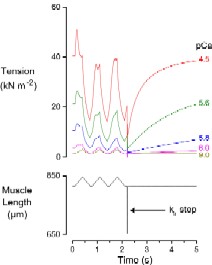 Fiber Length Control
Fiber Length Control
This figure shows the measured tension response of a canine myocardial preparation to three triangular length changes (paired ramp stretches/releases) followed by a ktr step. Records obtained at 5 different levels of Ca2+ activation are superimposed.
SLControl allows the user to vary the number, the size and the shape of the triangles. For example, you can replace the symmetric triangles shown in this example with saw-tooth ramps, or even incremental ramps which build successively. The user can also set the duration and the magnitude of the ktr control step. Judicious adjustment of the control parameters allows a wide variety of experiments to be performed. An extreme example occurs if the user specifies 0 triangles/ramps, and a ktr step of 0 size, parameters which ensure that SLControl records data passively without making any adjustments to the motor position.
Different experimental modes allow the user to perform successive measurements in which one parameter (for example, stretch speed) is adjusted according to a pre-defined pattern. This option allows the user to determine the effect of the experimental parameter (in this case stretch velocity) in a single experiment without subjecting the muscle preparation to repeated activation cycles.
The sampling rate per channel can be varied at will from 100 Hz to 2500 Hz, and up to 65000 data points per channel (~11 minutes at 100 Hz, 26 s at 2500 Hz) can be written to disk in a single experiment.